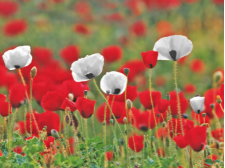Uncategorized
Blog: The Challenge of Remembrance
On 07, Nov 2017 | In Uncategorized | By Nicola Gauld
Recently Symon Hill, Co-ordinator at the Peace Pledge Union (PPU), participated in a couple of early morning live chat programmes on the BBC and ITV. Subsequently he received a torrent of abuse on social media, much of it of a personal nature. What terrible thing had Symon said to spark this level of abuse?
On both programmes, the other participants were there to support the Red Poppy as the symbol of remembrance for British service men and women killed in War. Symon, on the other hand, had had the temerity to suggest the White Poppy as an alternative symbol since, as he explained, white poppies are worn by people who wish to remember all victims of war, including civilians, who now in current conflicts account for over 90% of casualties. He also expressed the PPU’s view that the red poppy has increasingly become associated with a glorification of war and a growing militarisation of British society. He said in contrast a white poppy is a symbol that challenged militarism as well as being a sign that the wearer wishes to build a culture of peace.
A critical view of the British Legion designed Remembrance ceremonies is deeply rooted in the history of the PPU. The PPU’s original pledge was I renounce war and will never support or sanction another. In Britain Canon Dick Sheppard in 1934 wrote a letter to a number of newspapers which eventually led to the founding of the PPU. Even before that, Dick Sheppard had opposed the official Remembrance ceremonies and he himself arranged the first Service of Remembrance in the Albert Hall on Armistice Day. In 1927 this was taken over by the British Legion in conjunction with the Daily Express, the origin of the present British Legion Festival of Remembrance at the Albert Hall, which is now dominated by the armed services and their relatives. A few years later Dick organised a peace gathering in Trafalgar Square at Remembrance time and similar alternative (non-military) ceremonies were held during the 1930s.
Public engagement in Armistice Day ceremonies declined, but as the likelihood of another war grew, renewed criticism of what many saw as militaristic values embedded in official Armistice Day celebrations became more common. It was in this climate that the white poppy emerged as a challenging and insistent symbol for peace without violence.
The white poppy arose from the concerns of the wives, mothers, sisters and lovers of the men who had died and been injured in World War One. Increasingly aware of the likelihood of another war, they chose this symbol ‘as a pledge to Peace that war must not happen again’. In 1933 the Women’s Co-operative Guild distributed the first white poppies. The following year the PPU joined with the Guild and later took over the much enlarged distribution.
As Symon will attest, today you challenge the militarisation of the red poppy at your peril.
Peter Glasgow, PPU



